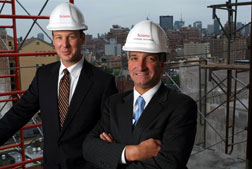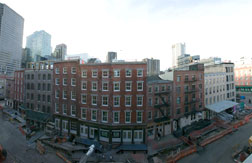 Michael Falco Joseph Mizzi (left), president of F.J. Sciame Construction, and Frank Sciame, chief executive.
|
Frank Sciame assessed his prospects as a designer after he graduated from the City College of New York with a bachelor’s degree in architecture in 1974. “I realized I wasn’t the next Pritzker Prize winner,” he says. But the path he traveled with F.J. Sciame Construction, the company he built, has led him to prestigious jobs on projects with recent Pritzker Architecture Prize winners in Renzo Piano, Thom Mayne and the Swiss design team of Jacques Herzog and Pierre de Meuron.
The New York City-based general contractor, which oversaw $177 million in construction contracts in 2005 in the New York region and is on target to oversee $186 million this year, has had a bumper crop of high-profile projects in the past year. The projects are part of a memorable stretch for Sciame, the company’s chairman and CEO. As the firm completed a highly complex, $102-million project designed by Piano at Manhattan’s Morgan Library & Museum, Sciame himself was ending his term as chairman of the New York Building Congress, an industry association.
As the firm prepared to start on the first Mayne design to be built in New York for an innovative academic center at Cooper Union for the Advancement of Art and Science, Sciame was embarking on his tenure as chair of the New York Landmarks Conservancy. And as the firm managed other sophisticated designs on museums and condominium buildings across the region, Sciame topped off a succession strategy by naming Joseph Mizzi to be the firm’s president in May.
Earlier this year, Sciame stepped into the city’s most emotional and controversial project when he agreed to prepare a report on ways to fix the troubled World Trade Center Memorial project, which will honor victims of the Sept. 11th attack. His review, which recommended $285 million in potential savings, drew virtually no backlash and was adopted largely intact weeks later by redevelopment officials.
 |
 |
 Sciame's roster of projects always seems to have complex tasks, such as the restoration of landmark buildings at Historic Front Street (top) in Manhattan, a delicate dig at the Morgan Library & Museum (middle) and the complicated double-wall exterior on Thom Mayne's new building at Cooper Union (bottom).
|
And somewhere in the mix is Sciame’s plan for a signature condominium tower designed by Santiago Calatrava, which awaits a financial green light. “The past year for me has been extraordinary with planning for whom will lead this company in the future and working on some of the most architecturally challenging projects in the city,” Sciame says. “And subtract from that five weeks to do a special assignment for the memorial.”
As Sciame moved through the swirl of New York’s building scene, he kept focus on elements that define his career, says New York Gov. George Pataki, who tapped the builder for the memorial report. “Frank clearly demonstrates an acute appreciation for architecture and historic preservation and is a great supporter of the rebuilding and revitalization of Lower Manhattan,” Pataki said in an e-mail.
The Building Congress’ President, Dick Anderson, says Sciame is on a roll. “They’re on a lot of good projects and he personally is involved deeply in this industry.”
F.J. Sciame is a true New York story. The company seldom wanders from its city base, occasionally taking assignments in the tri-state area suburbs. It typically runs about a dozen jobs valued between $25 million to $100 million, along with smaller interiors jobs, and relies on a staff of 125 between the field and its headquarters in lower Manhattan. And along the way, it has built a niche in construction of high-end designs by well-known architects, especially for institutions such as universities, museums, schools, and libraries, as well as on specialized residential projects.
“He has positioned Sciame Construction as a quality firm that can be as selective as its clients, and has become the premier general contractor for cultural and education institutions,” says Anderson “That’s a nice place to be in this market.” Clients also cite Sciame’s attention to detail and dedication. “When Frank is on the job, you know it’s going to get done,” says Julian Schnabel, a painter and filmmaker who hired Sciame to add nine floors above his four-story Manhattan studio to house new condominiums.
|
Sotheby’s Job a Turning Point
Sciame, 55, said he started the company in 1975 on a diet of smaller interior jobs around the city and over time began adding staff, projects, and experience. The watershed moment came in 1980, when the firm won a $6-million assignment to renovate a Sotheby’s auction space in Manhattan. Since then, the firm has grown considerably, taking on prominent projects such as construction of the Seamen’s Church Institute in Lower Manhattan, a building noted for merging historical and nautical influences, as well as reconstruction of the New Victory Theater in Times Square, the city’s oldest theater.
The Morgan library project on the eastern edge of Midtown Manhattan was one of the most complex.
“From the hunt in terms of landing the project and all the way to the dedication, that project had challenge written all over it,” Sciame says. “We knew Renzo Piano would deliver a great building.”
The project involved a complex façade and advanced archival equipment, though some of the hardest work was below grade. “The dig–the underpinning, line drilling, excavation–was a ballet of heavy machinery,” Sciame adds. “We had three or four ramhoes in the hole at one time to maintain the schedule.”
The ability to handle the Morgan came from accumulated experience managing slightly bigger and more complicated jobs over the years, says Jim Kilkenny, an executive vice president who joined the firm 28 years ago as its first project manager, handling a $40,000 showroom renovation.
“We got a little bigger and just kept growing and growing,” he adds. “Frank kept raising the bar, and I had to scramble over it sometimes.” But Sciame said the firm has never gotten ahead of itself. “We control our volume,” he added. “We do not subscribe to taking a job and finding the team to run it.”
Sciame’s work on prestigious projects generates new contracts. George Campbell, president of Cooper Union, says, “Thom Mayne is one of the great architects of his time, and he put many innovative features in the building, a lot of which involve sustainability. We looked at Sciame’s prior projects, the Morgan in particular, and we looked at the team he uses. That was a big plus.”
In the RFP for the Morgan library, Sciame presented competitive numbers, fee structures, and working methods–and then it stood out, says Brian Regan, the library’s deputy director.
“We were struck by how uniformly they were respected. People who had worked with them felt very good about the relationship and the results of construction. It’s an unusual company.”
Another Sciame project has been tricky not only in technical terms but also because of a debate over its merit. The $65 million reconstruction of the former Gallery of Modern Art at 2 Columbus Circle into the Museum of Arts and Design drew opposition from some preservationists who wanted to keep the monolithic, windowless building intact.
But Sciame said he weighed the arguments and decided to pursue the project anyway, which will reconstruct the façade and much of the structure.
“There were people on both sides of the aisle,” he says. “There was enough of a split that I had no problem being the contractor and being a preservationist. I would have a problem if you asked me to demolish the [historic] Farley Post Office.”
Preservationist Tendencies
As the company managed notable projects, Sciame was enlarging his civic profile. He served until January as chairman of the Building Congress, an umbrella organization of builders, developers, engineers, architects, subcontractors, and other industry firms in the city. This year, Sciame became chairman of the New York Landmarks Conservancy for a two-year term, a post that underscores his stature in the preservation community, says Robert Tierney. He is chair of the New York City Landmarks Preservation Commission, which oversees landmarked buildings.
“There is no one more respected and admired in his field when it comes to construction on the iconic city landmarks,” Tierney says.
Ten years ago, Sciame added development to his company’s mix of businesses, focusing mainly on a handful of primarily residential projects. The most prominent was the 172,000-sq.-ft. reconstruction and revitalization of Historic Front Street in Manhattan’s South Street Seaport Historic District, which the firm took on with two New York City-based partners, Zuberry Associates and the Durst Organization.
The $47 million project, financed in part through $38 million from the federal Liberty Bonds program and completed last year, restored eleven landmark 18th Century warehouses and built three new apartment buildings. The development company also purchased the 80 South St. headquarters on the site Sciame hopes to use to build the tower by Calatrava. And it pursues projects that use other builders, including a 50-home development in Claverack, N.Y., which has a local contractor.
Construction is the primary business, however, and as it has grown, Sciame has positioned top staff to take over more responsibilities. The biggest move was promoting Mizzi, who had just finished overseeing construction of the Morgan library project, to president. “He is the complete package,” Sciame says. “The chemistry, the philosophy of the company, you find it in Joe.”
The promotion’s early May timing could not have been better. Only weeks later, state and city officials surprised Sciame with a request to review the Sept. 11 memorial project. Mizzi took over day-to-day operations right away as the memorial work tied up Sciame. “I told my wife that my life was going to be on hold for five weeks,” Sciame says.
Sciame executed well, Anderson says. “I’m not sure how many other industry executives who are his peers would have taken on the assignment,” he adds.
Now, back at the helm of his firm, Sciame says he is wary of the predictions for a construction boom in New York. “I think the spiking costs and the record volume that the city’s going to face can be viewed as a boom or a bust for the industry because it’s easy for contractors or subcontractors to take on more work than they can handle,” he says. “We want to make sure our work is going to the right subcontractors.”
Still, Sciame predicts steady growth for his firm. He says while he sees the potential for it to one day rival the region’s billion-dollar leaders, that isn’t his goal.
“If the right project or projects come along, I could see us being a billion-dollar company in five years,” he adds. “On the other hand, I could see us growing at a slower pace, and that is fine, too. The ideal projects in terms of challenge, in terms of visibility, in terms of importance, are the projects that we’re working on.”
 Related Links:
Related Links: 




Post a comment to this article
Report Abusive Comment